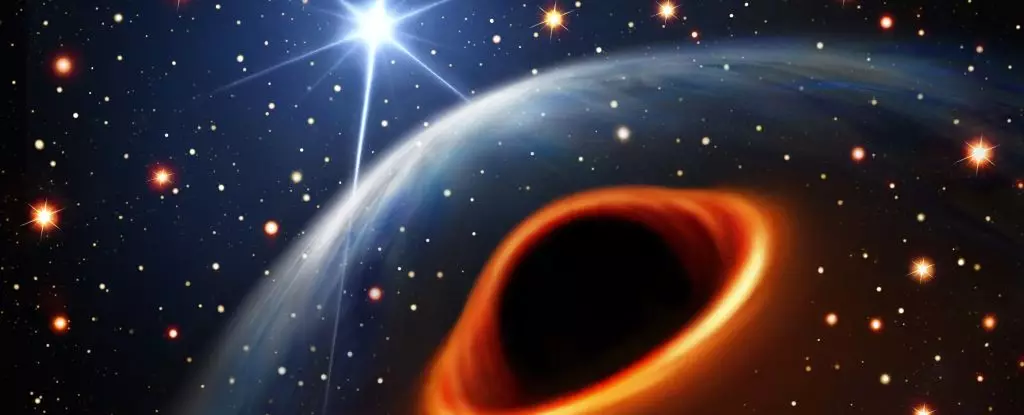In the vast and enigmatic expanse of our galaxy, the identification of a peculiar red giant star has sparked renewed excitement among astronomers. Located approximately 5,825 light-years from Earth, this star exhibits unusual movement, resembling a slow, graceful waltz with an elusive companion. However, the mystery intensifies as this supposed companion—expected to emit light—remains completely undetectable. This latest celestial peep show, conducted by a team led by astronomer Song Wang of the Chinese Academy of Sciences, reveals intricacies tied to celestial physics and the nature of black holes, particularly one of lesser-known dimensions.
The investigation into this unusual stellar pair has led scientists to assign a mass of approximately 3.6 times that of our Sun to the invisible object orbiting the red giant. This finding points towards it being a black hole residing within a region commonly described as the ‘mass gap, a term used to denote a scarcity of known black holes in a particular mass range. Named G3425, this black hole offers a crucial opportunity to delve deeper into our understanding of dwarf black holes, particularly regarding their origins, characteristics, and formation processes.
Research conducted by Wang and his colleagues emphasizes the unique qualities of G3425, especially regarding its ordering within binary systems. They argue that the revelation of G3425 serves as vital evidence for the existence of mass-gap black holes that remain undetected by traditional means, such as X-ray emissions. Their findings challenge prominent theories surrounding binary evolution and the dynamics of supernova explosions—forces that are supposed to disrupt such celestial pairings.
To comprehend the significance of G3425, it is essential to grasp the lifecycle of stars and their transformation into dense remnants. Standard stellar evolution posits that a star’s life culminates in a dramatic collapse under its gravitational pull after it exhausts its nuclear fuel. Depending on its initial mass, a star may transform into different cosmic relics, such as white dwarfs, neutron stars, or black holes.
Specifically, a mass threshold exists which delineates the types of remnants formed. A white dwarf emerges from stars up to about eight solar masses, capped by a mass limit around 1.4 solar masses. Neutron stars arise from more massive entities, with a plausible upper mass limit around 2.3 solar masses. Beyond this threshold, conventional theories posit that gravitational pressures lead to a complete collapse, yielding black holes. Yet, this is precisely where scientists encounter the ‘mass gap’—a perplexing void of black hole candidates within the range of roughly 2.3 to 5 solar masses.
The apparent scarcity of low-mass black holes raises essential questions about their formation and persistence. Current models struggle to account for the lack of candidates in the lower mass range, leading to speculation about either observational limitations or the existence of undiscovered, stable black holes occupying this elusive space in the black hole population.
The European Space Agency’s Gaia mission offers an invaluable resource in addressing this cosmic enigma. By mapping the Milky Way’s three-dimensional structure, including the movements and velocities of various stars, Gaia facilitates the discovery of typically hidden gravitational interactions. It equips researchers with the capacity to scrutinize stars that engage in elusive dances with invisible companions—just as Wang’s team undertook with G3425.
Using advanced spectroscopy techniques, researchers examined the light of the red giant star, revealing insights about its mass (approximately 2.7 solar masses) and the nature of its orbit. The meticulous observations highlighted that G3425 contributes vital information, particularly due to its relatively stable and circular orbit—a characteristic atypical for other stellar-mass black holes that tend to exhibit more erratic, elliptical trajectories.
The profound implications of G3425 extend beyond its immediate stellar dynamics. This discovery challenges existing theories regarding binary systems, derived from our understanding of supernovae dynamics, by suggesting that certain black holes can maintain stability under conditions previously deemed inconsistent.
To uncover greater insights surrounding G3425 and to address the broader questions regarding the formation and distribution of low-mass black holes across our galaxy, scientists must pursue more extensive observational campaigns. By defining the behaviors and traits of these elusive objects, they can establish a more comprehensive framework for understanding the underlying mechanics of stellar evolution.
Ultimately, the ongoing quest for knowledge about G3425 extends the horizons of astronomy, reminding us that the universe harbors cosmic mysteries just waiting to be unveiled. As researchers continue to probe the depths of space, the answers found may redefine our grasp of black holes and the intricate tapestry of stellar life.


Leave a Reply